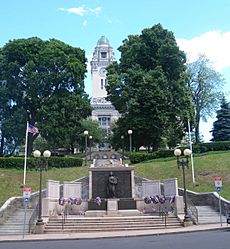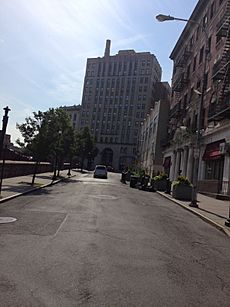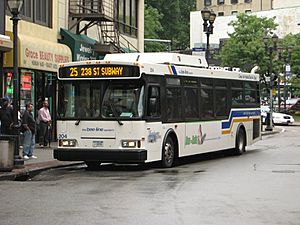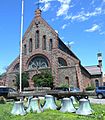Getty Square facts for kids
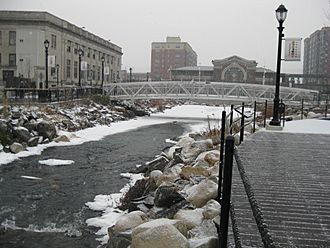
Getty Square is the busy downtown area of Yonkers, New York. It's like the main hub of the city, where you'll find the city's government buildings, lots of businesses, and a major transportation center. This area is growing and has many homes. It's located in the southern part of Westchester County, New York. The square is named after Robert Getty, an important merchant from the 1800s.
Contents
History
How Getty Square Started
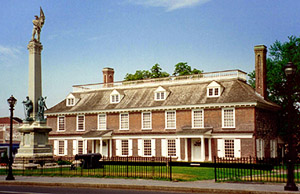
Getty Square is named after Robert Parkhill Getty, a well-known merchant and leader in the 1800s. This area was first settled by the Dutch. A man named Adriaen van der Donck, who was the first lawyer in the New World, built mills here. These mills used the power of a river, which was first called the Saeck Kill, then the Nepperhan River, and is now the Saw Mill River.
The two oldest buildings still standing in Getty Square are Philipse Manor Hall, built around 1682, and St. John's Protestant Episcopal Church, built in 1752. Both were built close to the river. The Hudson River, which is west of Getty Square, was used for transporting goods to markets starting in the 1600s. When the Erie Canal was finished in 1825, even more goods could travel by water from upstate New York down the Hudson River to Manhattan.
Growing with Factories and Trains
In 1853, Elisha Graves Otis, who invented the safety elevator, started the Otis Elevator Company near the Hudson River. As the company grew, it built a much larger factory north of the Saw Mill River, where Van der Donck Park is now. These huge factory buildings covered many blocks.
Later, three different railroad companies built lines through Getty Square. The New York and Putnam Railroad had a station here. The New York Central Railroad also had a station, which is still used today. The Third Avenue Railway ran streetcars, also called trams, through Getty Square. They stored their streetcars in the Yonkers Trolley Barn, which is still standing.
Changes Over Time
After World War II, Getty Square, like many downtown areas, faced some tough times. Factories started closing, and transportation systems that weren't for cars were not kept up. The large Otis Elevator Company factory closed in 1983. Train services also decreased. The Yonkers Branch of the New York and Putnam Railroad closed in 1944, and the Third Avenue Railway trolley service ended in 1952.
The Saw Mill River, which was once so important for the area's economy, was buried underground in the 1920s. The land above it was then used mostly for parking lots. A new highway was built, which meant a library had to be torn down.
Even through these changes, the farmers' market at St. John's Church is the oldest one in Westchester County, New York.
New Beginnings
In the 2000s, things started to change for Getty Square. The old Otis Elevator Factory became the iPark business center, bringing in new companies. Kawasaki Heavy Industries opened a railcar assembly plant there. In 2011, iPark put the largest solar panel system in Westchester on its roof to provide cheap electricity. Other companies like ContraFect (a biotechnology firm) and Mindspark Interactive Network also moved to iPark. In 2013, a project called YONY started to encourage more technology companies to come to the area.

In 2007, the Science Barge found its permanent home near the train station. The Science Barge is a special farm that floats on water and uses solar and wind power. It grows food using hydroponics (growing plants in water) and aquaculture (raising fish). It attracts many students and researchers interested in science, the environment, and farming.
The Saw Mill River, which helped Yonkers grow centuries ago, is now being used to help the economy again. After being buried underground for many years, parts of the river in Getty Square were "daylighted" in 2012. This means the river was uncovered and a new park, Van der Donck Park, was built around it. This park has become a beautiful public space.
Van der Donck Park was the first step in uncovering the river. More parts of the river are planned to be uncovered in the future, which will create more green spaces in Getty Square.
Shopping District
Getty Square is a very busy shopping area with many different cultures. Lots of people come here to shop, including customers from various backgrounds.
There are also farmers' markets and a CSA (Community Supported Agriculture) program. The market at St. John's Episcopal Church is open on Thursdays, and Groundwork holds a market on Fridays in Van der Donck Park. The St. John's Church market is the oldest farmers' market in Westchester. You can even use government assistance programs to buy produce at these markets.
Many banks have branches in Getty Square, including Chase, Wells Fargo, Citibank, HSBC, and Bank of America. Regional banks and credit unions are also here.
Kawasaki Heavy Industries Rolling Stock Company, which makes train cars, is also located in this central business area.
Transportation Hub
Getty Square is a major transportation hub for Yonkers and Westchester. This means many different types of transportation meet here, making it easy for people to get around. Bee-Line buses, MTA express buses, Metro-North Railroad trains, and Amtrak trains all come together in Getty Square.
Getty Square has a "Walk Score" of 95 out of 100. This means it's a "Walker's Paradise," where you don't need a car for your daily activities. It's the highest Walk Score in Westchester, making it a great place to live without a car. Because it's so easy to walk and has so many transportation options, the area is being developed to encourage less car travel and more walking, biking, and public transit use.
Buses
Many Bee-Line Bus and MTA Express Bus routes serve Getty Square. Millions of people use these buses every year. Yonkers is the most popular starting and ending point for bus trips in Westchester and the northern Bronx. Some bus lines go through Getty Square, while others loop around the neighborhood. The MTA Express Bus lines can take you directly to midtown Manhattan. You can use a Metro Card on buses in Getty Square.
There are plans to expand bus routes in the future. For example, a proposed express bus route from Spring Valley in Rockland County might end in Getty Square.
Trains
Metro-North Railroad trains serve Getty Square. People use the Yonkers station to catch Hudson Line and Amtrak trains. Metro-North trains go south to the Bronx, Harlem–125th Street, and Grand Central Terminal in Manhattan. They also go north along the Hudson Line as far as Poughkeepsie.
Many Metro-North riders connect to the New York City Subway at Marble Hill for the west side of Manhattan, and at Harlem–125th Street for the east side of Manhattan.
Amtrak also serves Getty Square. The Yonkers train station is the only Amtrak station in southern Westchester on the Hudson River Line. This means you can take Amtrak trains from here to cities in the US and Canada like Albany, Syracuse, Rochester, Buffalo, Montreal, and Toronto.
Other Ways to Get Around
Taxi stands are located in the heart of Getty Square along New Main Street and at the Yonkers Train Station. Taxis are often used by shoppers carrying many bags.
Car sharing services like Zipcar have been available near the Yonkers Train Station since 2012.
Ferry service between Yonkers and other parts of New York City and the Hudson Valley ended in 2010. However, you can still dock boats at the Yonkers Pier.
Bicycles are used often in Getty Square, mostly for getting to places rather than for fun. Many businesses use bikes for quick local deliveries. Kids also use them to get around. Warburton Avenue and Riverdale Avenue, which meet in Getty Square, are popular routes for people who bike to work or school in Westchester.
LimeBike started its bikeshare program in Yonkers in May 2018, allowing people to rent bikes easily.
There are also plans for walking and bicycling trails in Getty Square. The Old Croton Aqueduct runs along the northern edge of the neighborhood. There's also a plan to turn the old Getty Square branch of the New York and Putnam Railroad into a trail. This trail would connect Getty Square and the waterfront near the Science Barge with Van Cortlandt Park. It would be a path for walking and biking, with parts on streets and parts off streets.
Images for kids




